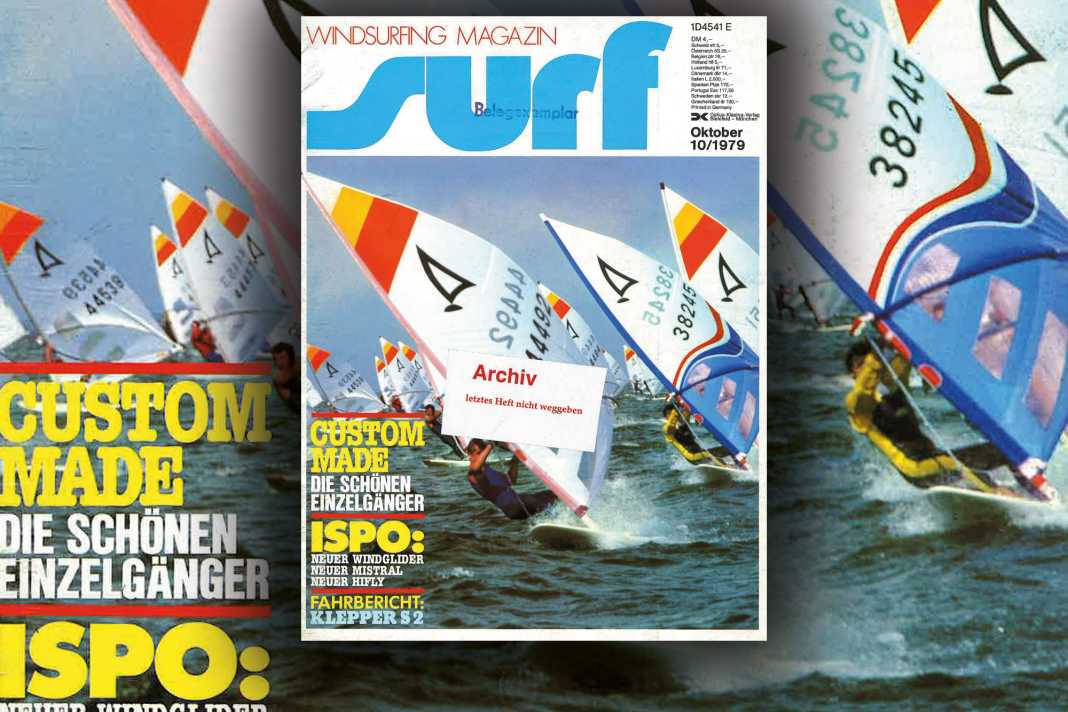





Surfer stress on the beach
"Order must finally be restored to the lakes!" an unknown person is quoted as saying in a Bavarian newspaper. What had happened? The windsurfing boom is causing a rift to form between surfers and swimmers, especially on the lakes of southern Germany, as Gerd Kloos gleefully explains in his commentary. From Quick to Süddeutsche Zeitung, there is a broad front in the press against the young sport: windsurfing is "making Germany's lakes and coasts life-threatening for swimmers this summer!" Windsurfers are "projectiles" with "razor-sharp aluminium swords" that are "murder weapons racing across the water at 50 km/h". In Munich, surfing is already banned on "all standing bodies of water above ground", and other lakes are also being successively closed. The water police, on the other hand, are "satisfied with the surfers" and a few collisions with swimmers are "trifles". Nevertheless, Kloos appeals to people to stick to the rules and show consideration!
ISPO innovations
In the early days, new and further development had a charming experimental character, which is entertainingly evident in the new windsurfing products at the ISPO sports trade fair: the trend is towards the third board, and in addition to sporty boards and all-rounders, many manufacturers have brought along a dedicated entry-level model ("excursion boat for mum"). The Astra Futura is a board that, apart from a humped up standing area, only consists of a hollow groove and round underwater hull, Ostermann shows the "Concorde". Mistral has the Naish as a radical Hawaiian board, and the price of 2590 marks is also radical: "We see no reason to sell this exclusive product cheaper!" The ancestor of modern iSUPs costs only around a fifth, namely 495 marks: an inflatable children's board with six chambers and a standing surface, which comes with a boom that can be used as a paddle. Another pioneer is Rudi Pröbstl from Allgäu, who has developed a new type of monoski for surfing on snow - the forerunner of the snowboard!
Custom Made-Special
surf explains the world of customised boards. To get a taste for it, some custom beauties are photographed in an elaborate studio production and shown as colour photos. Because in 1979, the shape is important, but customised graphics on the boards are also a reason for many to turn away from standard boards. With Jürgen Hönscheid and the Sylt label "Tiki", Concrete Wave and J. J., there are three suppliers in Germany. Inspiration comes from the surfing scene, which, however, cannot always keep up with the greater demands of windsurfing. One of them is Michel Barland, who surf visits in his workshop. His company actually manufactures machine parts, but the boss prefers to tinker with boards in an adjoining room. Barland himself is a surfer and always feels a little uncomfortable building windsurf boards. When he asks the surf reporter for his opinion on various details, his response is always "I've heard it differently." When he is asked to swing the plane a little for the photo, he has turned the blank into a ready-to-laminate board within 43 minutes. Apart from a rough template for the outline, it's all in the hollow of his hand. Barland dreams of one day having part of the shaping work done by the computer. And he realises that for some customers, function follows form: "Sometimes I can't shake the feeling that for many, the design is more important than the driving characteristics."
You can click through the entire magazine in the gallery above!
And what else?
- And eternally greets the Hoyle: This issue of surf is also not without some kind of patent dispute. Two months after the furious cancellation of the contract with the European sidekick Ten Cate, Schweitzer's lawyers have reached an agreement with the Dutch to "continue the cooperation in harmony".
- National goalkeeper Sepp Maier was photographed windsurfing at his local Feringasee lake near Munich. Maier commented on the pararazzi pictures in an unusually bad-humoured manner with "Jesus, do you all know it?"
- In a full-page advert, the "Verband Deutscher Windsurfing Fachhändler" (Association of German Windsurfing Retailers) claims that it and its members are committed to quality and service because "many mistakes are being made in the development of this still young sport".
- surf analyses the injuries suffered by its readers. Conclusion: windsurfing is relatively safe, most injuries are to the legs and feet, often caused by falls and contact with the mast and/or board
- Klepper presents its first surfboard, the S2. In the test, the shape of the somewhat dusty sailing dinghy shipyard is convincing, but the strange footprint raises big question marks
- Walchensee has an excellent reputation as a thermal area, surf presents the lake - to the annoyance of some editors who fear an even bigger rush. The local authorities have not only set up their own surfing zones, but have also erected stands for the rigs. What was scarce then, as it is now, are car parks.
- At a regatta in France, the locals bring along colossal daggerboards up to 1.50 metres long
More surf reviews:
- surf 4/1977
- surf 6/1977
- surf 6/1978
- surf 4/1979
- surf 9/1980
- surf 11/1980
- surf 4/1981
- surf 5/1982
- surf 6/1982
- surf 4/1983
- surf 10/1983
- surf 9/1984
- surf 12/1984
- surf 8/1985
- surf 8/1986
- surf 9/1986
- surf 2/1987
- surf 5/1987
- surf 8/1988
- surf 5/1989
- surf 7/1989
- surf 4/1990
- surf 3/1991
- surf 6/1991
- surf 3/1992
- surf 10/1992
- surf 9/1993
- surf 10/1993
- surf 4/1994
- surf 7/1995
- surf 6/1996
- surf 11-12/1996
- surf 7/1997
- surf 8/1998
- surf 9/1998
- surf 4/1999
- surf 7/2001
- surf 5/2005
- surf 3/2006

